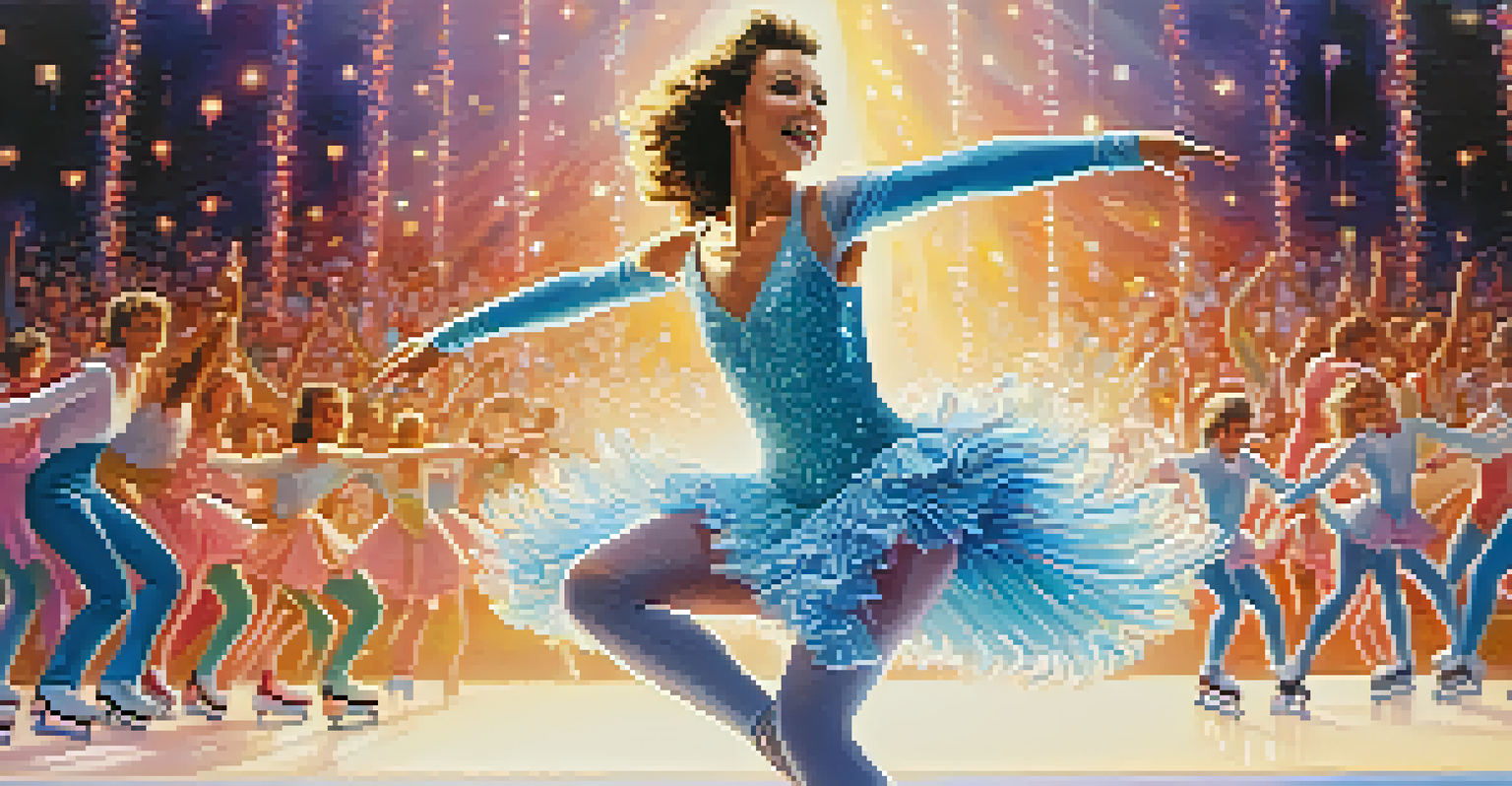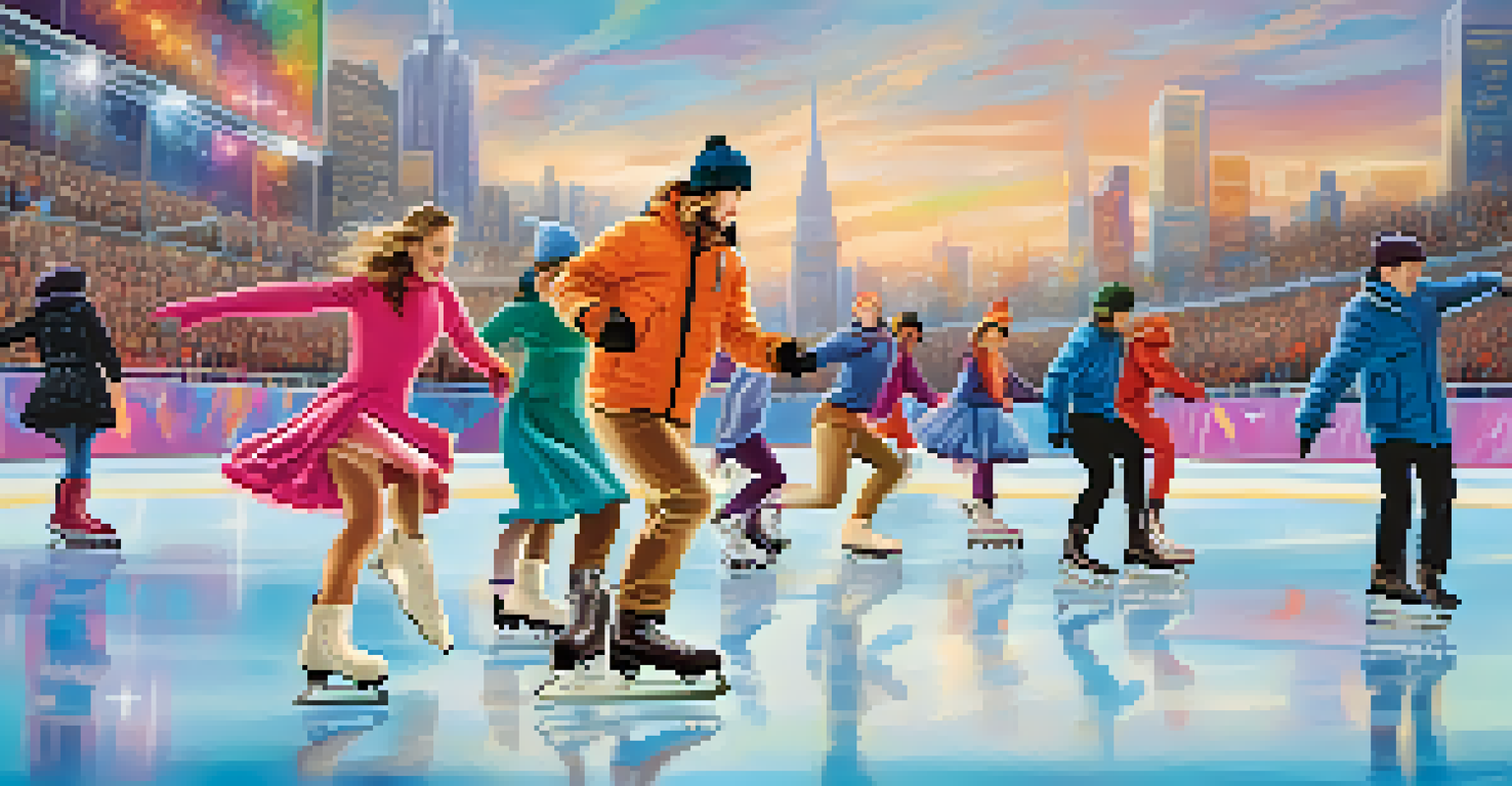The Evolution of Ice Skating Fashion Over the Decades

The Birth of Ice Skating Fashion in the 19th Century
Ice skating first gained popularity in the 19th century, and with it came a unique sense of style. Early skaters donned practical clothing that allowed for movement, often consisting of long skirts for women and loose trousers for men. This was a time when function was key, as the goal was to enjoy the sport rather than make a fashion statement.
Fashion is like a language. You can speak it with your clothing, and it tells a story about who you are.
Interestingly, the materials used back then were quite different from today’s fabrics. Wool and heavy cotton were popular choices, providing warmth but often sacrificing comfort and flexibility. As ice skating became more than just a pastime and started to attract spectators, the need for visually appealing outfits began to emerge.
By the end of the century, skating outfits began to incorporate more decorative elements, such as lace and embroidery, setting the stage for the future of ice skating fashion. This initial blend of practicality and elegance laid the groundwork for the evolving styles we would see in the coming decades.
The Roaring Twenties: Glamour on Ice
The 1920s ushered in an era of glamour that greatly influenced ice skating attire. With the rise of jazz and the flapper movement, skaters began to wear more daring outfits that emphasized freedom and fun. Women's dresses featured shorter hemlines and more embellishments, such as sequins and feathers, reflecting the lively spirit of the decade.

Men's fashion also evolved, with tailored suits and stylish hats becoming popular on the ice. This shift towards more fashionable outfits was not just about aesthetics; it marked a cultural change where sports became intertwined with entertainment. Skaters started to gain celebrity status, and their outfits played a crucial role in their public image.
Evolution of Ice Skating Fashion
Ice skating fashion has transformed from practical attire in the 19th century to a vibrant expression of individuality and style in today's world.
The impact of Hollywood also cannot be overlooked, as film stars like Sonja Henie brought ice skating into the limelight. Henie's dazzling costumes inspired many and set a new standard for what ice skating fashion could be, showcasing how performance and style could go hand in hand.
The Mid-Century: Function Meets Flair
As we moved into the mid-20th century, the world saw a blend of function and flair in ice skating fashion. The post-war era brought a focus on practicality, yet designers began to experiment with innovative materials that enhanced both comfort and movement. Skaters started to wear fitted bodices and flowing skirts that allowed for greater freedom while maintaining a fashionable appearance.
Style is a way to say who you are without having to speak.
This period also saw the introduction of figure skating competitions, which emphasized the importance of a skater's outfit. Coaches and skaters recognized that a well-designed costume could enhance performance by allowing for better mobility, while also captivating the audience with stunning visuals. Skating became a spectacle, and outfits were an integral part of the show.
Moreover, the rise of television in the 1950s meant that skaters could reach a wider audience. Viewers became enamored with their favorite skaters, and the fashion choices they made became a topic of conversation, influencing trends both on and off the ice.
The Colorful Sixties and Seventies: Bold Expressions
The 1960s and 70s were a time of bold expression in ice skating fashion, as vibrant colors and daring designs took center stage. This was the age of self-expression, and skaters began to showcase their personalities through their outfits. Think bright patterns, psychedelic prints, and an array of textures that made performances unforgettable.
Skaters like Peggy Fleming and Robin Cousins captured the spirit of the times with their stunning costumes that often resembled works of art. Outfits became more than just clothing; they were an extension of the skater's identity, with each performance reflecting their unique character. This shift marked a significant departure from the more conservative styles of previous decades.
Cultural Influences on Skating Style
Each decade's ice skating fashion reflects broader cultural trends, from the glamour of the 1920s to the extravagance of the 1980s and the modern push for sustainability.
Additionally, the influence of pop culture and music trends played a significant role in shaping skating attire. The fusion of ice skating with the counterculture movement allowed skaters to push boundaries, creating a vibrant, eclectic style that resonated with audiences worldwide.
The Eighties: Extravagance and Showmanship
The 1980s brought a wave of extravagance to ice skating fashion, characterized by bold silhouettes, dramatic embellishments, and flashy colors. Skaters embraced the idea of 'bigger is better,' with outfits featuring oversized bows, ruffles, and even sequined bodysuits that dazzled under the rink lights. This was the decade of showmanship, where skaters aimed to leave a lasting impression.
The influence of pop icons like Madonna and Prince permeated the skating world, with outfits reflecting the glam and excess of the time. Skaters began to incorporate elements from music and dance, blurring the lines between athleticism and performance art. This era transformed the ice rink into a stage, where every twirl and jump came with a flair for dramatic fashion.
The 1980s also saw the rise of professional skating competitions, leading to increased media attention. As skaters became household names, their fashion choices were scrutinized and celebrated, making every costume change a potential trendsetter for aspiring young skaters.
The Nineties and Early 2000s: A Return to Elegance
As we entered the 1990s and early 2000s, ice skating fashion began to shift back towards elegance and sophistication. Designers started to focus on clean lines and classic styles, moving away from the excess of the previous decade. This return to elegance was characterized by sleek bodices and flowing skirts, allowing skaters to showcase their technical skills without overwhelming their performances.
Skaters like Michelle Kwan exemplified this shift with their stunning, timeless costumes that often featured intricate detailing without being overly flashy. This era emphasized grace and artistry, with outfits that complemented the skater's movements and enhanced the overall performance. Simplicity became a powerful statement.
The Role of Performance in Fashion
As ice skating evolved into a competitive sport, the design of costumes became crucial for both performance enhancement and visual appeal.
Moreover, the introduction of ice dancing as a competitive discipline also influenced fashion choices. Couples began to coordinate their outfits, showcasing a harmony that reflected their partnership on the ice. This led to a more cohesive fashion narrative that resonated with both judges and audiences alike.
The Modern Era: Innovation Meets Sustainability
Today, ice skating fashion is at an exciting crossroads, where innovation meets sustainability. Designers are increasingly focusing on eco-friendly materials, ensuring that skaters not only look good but also make responsible choices for the planet. This growing trend reflects a broader cultural shift towards sustainability in all aspects of life.
The modern skater's wardrobe often features high-tech fabrics that enhance performance while providing comfort and flexibility. Athletes can now choose from a range of styles that not only celebrate individuality but also incorporate cutting-edge technology, like moisture-wicking materials and temperature control.

Moreover, the influence of social media has transformed how skaters showcase their fashion. Platforms like Instagram allow skaters to share their unique styles with a global audience, encouraging a vibrant community of fashion-forward athletes. This interconnectedness ensures that ice skating fashion continues to evolve, drawing inspiration from diverse cultures and trends.